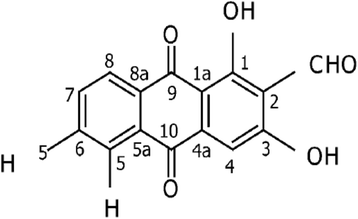Subchronic toxicity, immunoregulation and anti-breast tumor effect of Nordamnacantal, an anthraquinone extracted from the stems of Morinda citrifolia L
- PMID: 29374471
- PMCID: PMC5787285
- DOI: 10.1186/s12906-018-2102-3
Subchronic toxicity, immunoregulation and anti-breast tumor effect of Nordamnacantal, an anthraquinone extracted from the stems of Morinda citrifolia L
Abstract
Background: Morinda citrifolia L. that was reported with immunomodulating and cytotoxic effects has been traditionally used to treat multiple illnesses including cancer. An anthraquinone derived from fruits of Morinda citrifolia L., nordamnacanthal, is a promising agent possessing several in vitro biological activities. However, the in vivo anti-tumor effects and the safety profile of nordamnacanthal are yet to be evaluated.
Methods: In vitro cytotoxicity of nordamnacanthal was tested using MTT, cell cycle and Annexin V/PI assays on human MCF-7 and MDA-MB231 breast cancer cells. Mice were orally fed with nordamnacanthal daily for 28 days for oral subchronic toxicity study. Then, the in vivo anti-tumor effect was evaluated on 4T1 murine cancer cells-challenged mice. Changes of tumor size and immune parameters were evaluated on the untreated and nordamnacanthal treated mice.
Results: Nordamnacanthal was found to possess cytotoxic effects on MDA-MB231, MCF-7 and 4T1 cells in vitro. Moreover, based on the cell cycle and Annexin V results, nordamnacanthal managed to induce cell death in both MDA-MB231 and MCF-7 cells. Additionally, no mortality, signs of toxicity and changes of serum liver profile were observed in nordamnacanthal treated mice in the subchronic toxicity study. Furthermore, 50 mg/kg body weight of nordamncanthal successfully delayed the progression of 4T1 tumors in Balb/C mice after 28 days of treatment. Treatment with nordamnacanthal was also able to increase tumor immunity as evidenced by the immunophenotyping of the spleen and YAC-1 cytotoxicity assays.
Conclusion: Nordamnacanthal managed to inhibit the growth and induce cell death in MDA-MB231 and MCF-7 cell lines in vitro and cease the tumor progression of 4T1 cells in vivo. Overall, nordamnacanthal holds interesting anti-cancer properties that can be further explored.
Keywords: 4T1; Breast cancer; Immunomodulation; Morinda citrifolia; Nordamnacanthal.
Conflict of interest statement
Ethics approval and consent to participate
All studies involving animals were conducted in compliance with the Universiti Putra Malaysia’s ethical guidelines as approved by the Animal Ethics Committee (UPM, Malaysia). The approval number obtained: UPM/IACUC/AUP-R098/2014.
Consent for publication
Not applicable
Competing interests
The authors declare that they have no competing interests.
Publisher’s Note
Springer Nature remains neutral with regard to jurisdictional claims in published maps and institutional affiliations.
Figures







Similar articles
-
Effects of Damnacanthal and Nordamnacanthal on Proliferation, Apoptosis, and Migration of Oral Squamous Cell Carcinoma Cells.Asian Pac J Cancer Prev. 2017 Dec 29;18(12):3333-3341. doi: 10.22034/APJCP.2017.18.12.3333. Asian Pac J Cancer Prev. 2017. PMID: 29286228 Free PMC article.
-
Anticancer Effects of Extracts from the Fruit of Morinda Citrifolia (Noni) in Breast Cancer Cell Lines.Drug Res (Stuttg). 2016 Mar;66(3):141-7. doi: 10.1055/s-0035-1555804. Epub 2015 Jul 9. Drug Res (Stuttg). 2016. PMID: 26158795
-
A new anthraquinone from Morinda citrifolia roots.Nat Prod Res. 2009;23(14):1322-9. doi: 10.1080/14786410902753138. Nat Prod Res. 2009. PMID: 19735047
-
Damnacanthal: a promising compound as a medicinal anthraquinone.Anticancer Agents Med Chem. 2014 Jun;14(5):750-5. doi: 10.2174/18715206113136660366. Anticancer Agents Med Chem. 2014. PMID: 24164045 Review.
-
Final report on the safety assessment of capsicum annuum extract, capsicum annuum fruit extract, capsicum annuum resin, capsicum annuum fruit powder, capsicum frutescens fruit, capsicum frutescens fruit extract, capsicum frutescens resin, and capsaicin.Int J Toxicol. 2007;26 Suppl 1:3-106. doi: 10.1080/10915810601163939. Int J Toxicol. 2007. PMID: 17365137 Review.
Cited by
-
Pharmacokinetics of Anthraquinones from Medicinal Plants.Front Pharmacol. 2021 Apr 15;12:638993. doi: 10.3389/fphar.2021.638993. eCollection 2021. Front Pharmacol. 2021. PMID: 33935728 Free PMC article. Review.
-
Oncolytic effects of the recombinant Newcastle disease virus, rAF-IL12, against colon cancer cells in vitro and in tumor-challenged NCr-Foxn1nu nude mice.PeerJ. 2020 Dec 8;8:e9761. doi: 10.7717/peerj.9761. eCollection 2020. PeerJ. 2020. PMID: 33354412 Free PMC article.
-
Morinda citrifolia L.: A Comprehensive Review on Phytochemistry, Pharmacological Effects, and Antioxidant Potential.Antioxidants (Basel). 2025 Feb 28;14(3):295. doi: 10.3390/antiox14030295. Antioxidants (Basel). 2025. PMID: 40227265 Free PMC article. Review.
-
Ultrastructural and Morphological Effects in T-Lymphoblastic Leukemia CEM-SS Cells Following Treatment with Nordamnacanthal and Damnacanthal from Roots of Morinda elliptica.Molecules. 2022 Jun 28;27(13):4136. doi: 10.3390/molecules27134136. Molecules. 2022. PMID: 35807381 Free PMC article.
-
The Anthraquinone Derivative C2 Enhances Oxaliplatin-Induced Cell Death and Triggers Autophagy via the PI3K/AKT/mTOR Pathway.Int J Mol Sci. 2024 Jun 12;25(12):6468. doi: 10.3390/ijms25126468. Int J Mol Sci. 2024. PMID: 38928176 Free PMC article.
References
-
- Calais G, Berger C, Descamps P, Chapet S, Reynaud-Bougnoux A, Body G, Bougnoux P, Lansac J, Floch OL. Conservative treatment feasibility with induction chemotherapy, surgery, and radiotherapy for patients with breast carcinoma larger than 3 cm. Cancer. 1994;74:1283–1288. doi: 10.1002/1097-0142(19940815)74:4<1283::AID-CNCR2820740417>3.0.CO;2-S. - DOI - PubMed
-
- Bouchard G, Therriault H, Geha S, Berube-Lauziere Y, Bujold R, Saucier C, Paquette B. Stimulation of triple negative breast cancer cell migration and metastases formation is prevented by chloroquine in a pre-irradiated mouse model. BMC Cancer. 2016;16:361. doi: 10.1186/s12885-016-2393-z. - DOI - PMC - PubMed
MeSH terms
Substances
Grants and funding
LinkOut - more resources
Full Text Sources
Other Literature Sources
Medical
Research Materials
Miscellaneous

